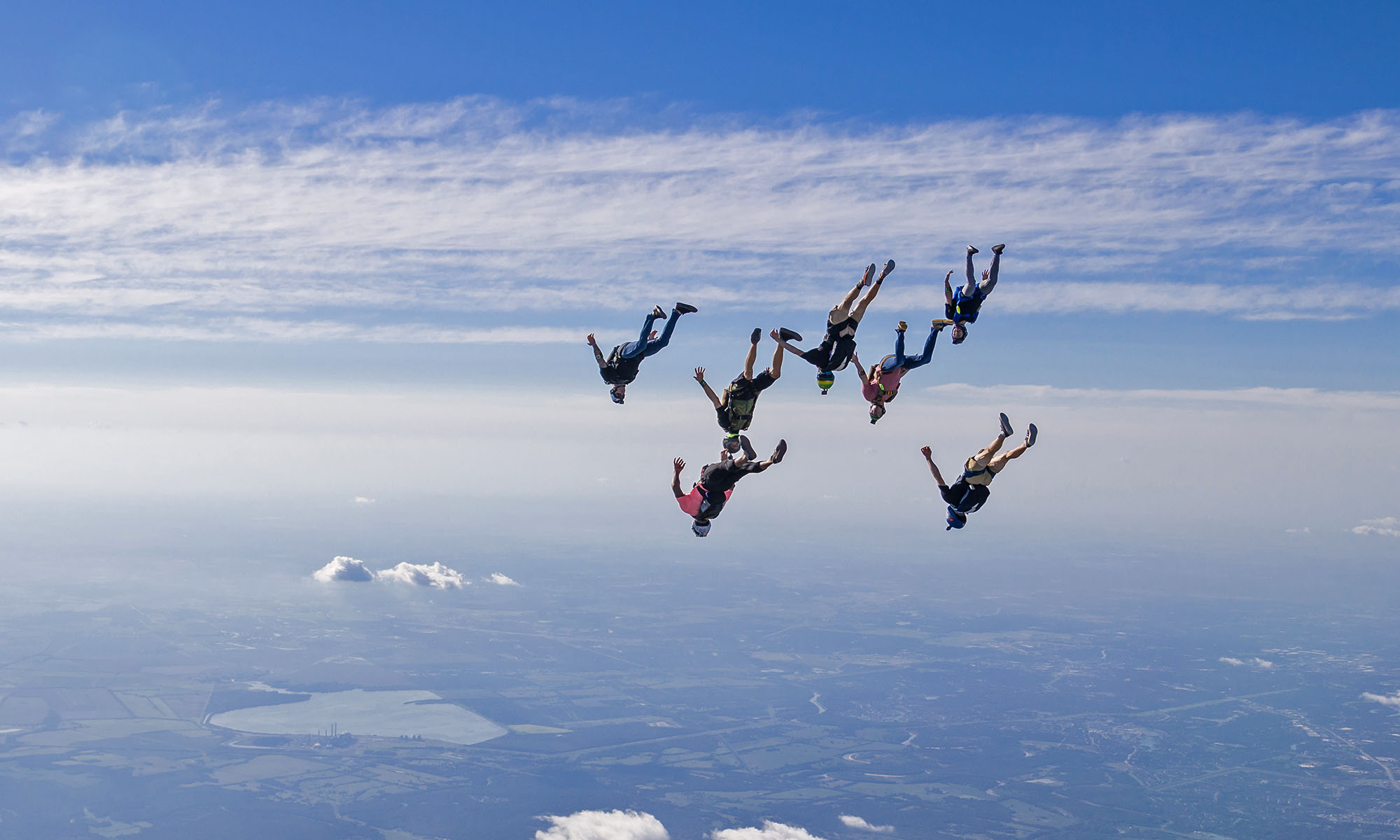How often have you heard this at the drop zone?
“Hey, let’s go track!” or “Hey, let’s go do some angles!”
Movement jumps are extremely popular at most any drop zone in the world, and with good reason: They’re a ton of fun! But they are most definitely not just another skydive.
Key Point: It’s extremely important that everyone doing movement jumps understands one critical fact: It is 100% YOUR responsibility to avoid the straight-down groups. Never the other way around. This type of skydive poses additional risks to everyone on the load and needs to be treated with absolute respect.
Here are 11 things to keep in mind to make your movement jump a safe, awesome experience.
- Should you be doing a movement jump at all? If you are not already an accomplished belly and freeflier (with good body control and awareness at least on belly jumps, and very importantly at breakoff from all skydives, and have done some basic delta tracking drills), the answer is definitely NO. Not until you have these prerequisite skills. Without them, you have a higher risk of injuring others on your group or the load due to not being skilled enough to follow the dive plan.
- Should you do a movement jump with this group? The size of the jump should be commensurate with your experience. If you wouldn’t do a belly fly or freefly jump with the number of people on the tracking dive, you absolutely shouldn’t do a movement jump with them. Lower-experienced jumpers have a greater chance of not being able to stay with a big group and thus may track away from that group early, potentially into another group. They may also become very dangerous during the jump if unable to control their closing speeds to other jumpers.
- Get approval for your movement jump. The dive leader needs to get approval from operations staff (pilot, DZ manager, etc.) for every single movement jump. This is especially critical if the dropzone is running multiple aircraft simultaneously. The airplanes may or may not fly the same jump runs all day and may fly offset jump runs, which will significantly affect your jump planning. There are times that movement jumps may simply not be approved, or only be approved on certain loads.
- Who’s in charge? The person leading the jump must:
- Be experienced at leading movement jumps
- Have worked with coaches on leading and/or taken a leading course
- Be familiar with the drop zone
- Know the direction of jump run
- Know the day’s winds at freefall and canopy altitudes
- Know the experience and capabilities of each person on the jump
- Have the confidence to let people know if they should not be on that skydive, and perhaps start with a smaller movement jump first
- Brief everyone on safe flight techniques
- What’s the plan?
- What is the planned flight path?
- What (if any) transitions are planned?
- Where will those transitions be (over what landmarks)?
- If doing anything but tracking in the skydive, how much time in the skydive will be spent tracking vs. how much time static-straight down?
- Where do you plan to open canopies?
- What’s your backup dive plan in case jump run changes significantly and/or clouds make your original plan unsafe?
- How are you ensuring your group will not be in another group’s airspace at pull time?
- Communicate with the rest of the load: The leader must know what other groups are on that load and what they’re doing. Also, everyone on the plane must know what you’re doing so they know where to expect you to be. When you do a movement jump, you are intentionally going away from the spot of air your group would occupy if you weren’t tracking. It is very easy for a fast group to cover a lot of ground. If you aren’t careful to take your group away from jump run, you can easily end up above or below other groups and put quite a few people in harm’s way. Near misses between movement groups and straight-down groups, in freefall or during/shortly after deployment, are increasingly common and extremely dangerous. A good organizer will keep these from occurring with a good plan, awareness of the composition of each load, and a good selection of capable skydivers for each jump.
- Time of day: A good spot is critical for last load of the day, since recovering people from off landings in the dark is no one’s idea of fun. As well, know any wind trends at your dropzone. Higher winds in the morning or evening, etc., need to be considered to be sure you’re not putting yourself in a bad spot when the winds pick up or die down.
- During the jump: The leader must maintain awareness of the group’s location and flight skill, and be able to adjust his/her flight angle/speed to keep the group together and moving in a safe direction.
- Course corrections: Particularly if the leader is tracking on his/her back, their visuals of ground references may be compromised. Highly experienced jumpers in the group can and should give course corrections if needed to maintain safety of the group (distance from jump run and spot). Leading on the back is only reserved for highly experienced, full-time professionals and even then, most are only leading on their back for a few moments in the jump.
- Opening altitudes: Open at the planned altitudes. Sometimes people may think to open higher if the spot is very long. But as you fly back to the drop zone at a higher than expected altitude, you run the risk of sneaking up on other canopy traffic or flying into another group still in freefall from unexpected directions, plus you put yourself at a higher risk of being close to aircraft that may not expect a parachute to be open high and far from the drop zone. You don’t show up on Air Traffic Control radar…
- Landing off: Your chances of landing off are much higher on a movement jump. In fact, one of the toughest things to manage on these jumps is maintaining a safe distance from other groups on the jump run while also keeping a good chance of landing at the DZ. When in doubt, though, stay further from jump run! Landing off is something we’ve all trained for from the beginning, and something most of us have done successfully. A freefall or canopy collision is much less likely to end well. Remember to look at any wind indicators you can find, pick a large, clear area early, and be prepared to do a parachute landing fall if necessary. The top advice here is: If you can’t safely lead your group or be led away from jump run AND ensure 100% everyone can also land back on the dropzone, then leading/jumping on that jump shouldn’t be done.
The sky is big, but it’s only so big when we are all taking off from and trying to land at the same place. Keep these points in mind to help ensure that we all get to play safely! 🙂
Updated March 2023

